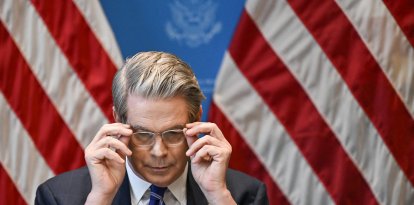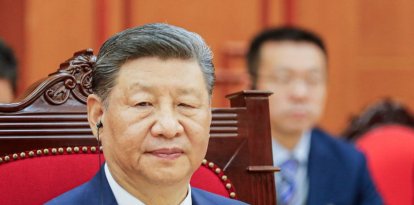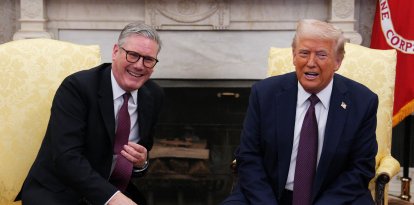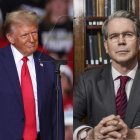Trump's Treasury Secretary's ambitious economic proposal to rescue the US economy
Scott Bessent's proposal includes reducing the fiscal deficit, growing above GDP projections and increasing oil barrel production.

Donald Trump and Scott Bessent months ago
Scott Bessent, President-elect Donald Trump's pick to lead the Treasury Department, has a clear plan to rescue and boost the U.S. economy: the '3-3-3' approach.
It is an ambitious economic agenda that sets the goal of, first, cutting the budget deficit to 3% of GDP, second, achieving annual growth of 3% and, finally, increasing domestic oil production by an additional 3 million barrels per day (currently thirteen million are produced).
Experts describe Bessent's plan as ambitious, but not impossible. And, the best part, it has the approval of the president-elect's fiscal hawks and pro-market allies. So it is no surprise that the markets reacted positively to Bessent's appointment to a pivotal position in shaping the next administration's economic policy.
Bessent will essentially be tasked with working with Trump to make the tax cuts the president promised during the campaign a reality and, even more difficult, set the tariffs that were so highly touted and successful during his rallies.
"He cares about deficits, he cares about economic growth and he recognizes that there is a huge connection between the two," said about Bessent Maya MacGuineas, chairwoman of the Committee for a Responsible Federal Budget, in a conversation with Axios. "His 3/3/3 framework is auspicious but would be a tremendous success if achieved."
The potential problem with Bessent's approach, according to Neil Irwin, chief economic correspondent for Axios, is the potential tensions that could exist between the economic proposal designed by the renowned hedge fund manager and Trump's immigration policies.
According to Irwin, for the U.S. economy to grow by 3%, which is growth above what is expected by long-term projections for the U.S. economy,there has to be synergy between labor supply and business productivity per hour worked.
For the expert, Trump's massive deportation plan and the tightening of immigration policies could generate fewer workers available in the country even if their status is illegal, which would be an obstacle to GDP growth if companies fail to increase productivity per hours worked.
Importantly, by 2025, the CBO projects that the potential labor force will increase by 1.2% and potential labor productivity will rise by 1%.This means a combined total growth of 2.2% in potential GDP, far from the 3% that Bessent puts forward.
To improve these forecasts, there is one hope: Bessent's pro-market approach and the potential deregulation planned by the Trump administration.
During Trump's first term, the U.S. economy performed well in large part thanks to the bureaucratization and deregulation plan and tax cuts pushed by the Republican president. In that regard, small and medium-sized businesses benefited, while minority net income also grew.
There is another point that could drive GDP growth: the AI revolution, which could start delivering productivity benefits very soon, especially if Trump delivers on his promise to create an enabling environment for entrepreneurs and large companies that want to invest large sums of money in the technology of the future.
RECOMMENDATION






















